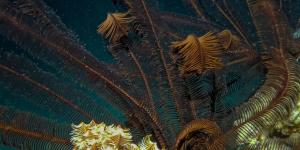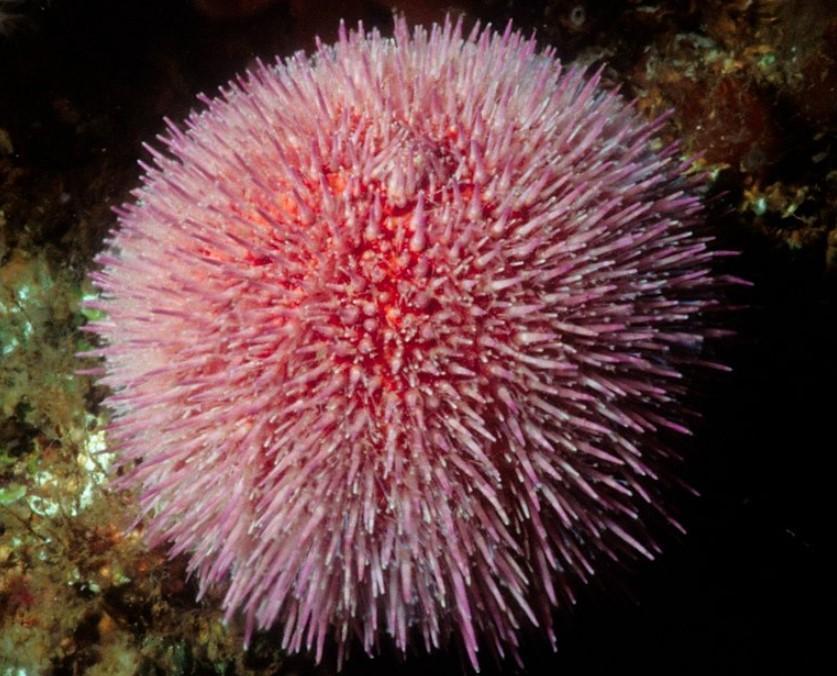Types of Sea Urchins


Sea urchins are small marine invertebrates which are characterized by having hard and spiny shells. They are sometimes simply called urchins, since there are no freshwater sea urchins to be found in nature. Despite only inhabiting saltwater aquatic ecosystems, they are an incredibly diverse type of echinoderm. All urchins are spiny, but the spines can vary greatly in terms of length and configuration. They range in color, tubercle orientation and other key features.
To get to know these incredible marine animals, AnimalWised shares 25 types of sea urchins to get an idea of their diversity. In addition to providing the names of different sea urchin varieties, we discover their main characteristics which define them.
What are sea urchins?
Sea urchins are invertebrate animals of the class Echinoidea found in marine habitats ranging from intertidal waters to the deep ocean. They are known for their globe shape and spiked skin. Like other echinoderms, urchins have five-fold symmetry (called pentamerism) and move by means of their tubular feet.
Sea urchins mostly feed on algae and small animals. In order to feed, they have a special chewing apparatus with which they can scrape organisms stuck to the surface over which the urchin moves. Of the approximately 950 species that exist, sea urchins can be classified into one of two broad categories:
- Regular urchins: are spherical in shape and their body is covered with numerous spines of varying lengths.
- Irregular urchins: are flattened and with much fewer and shorter spines, consisting of kinds of sea urchin known as sand dollars.
We look at these two classifications of sea urchin by providing information on individual species below. You can also learn some more background information about the group of animals to which sea urchins belong with our article asking what are echinoderms?
Types of regular sea urchins
As we have explained, regular sea urchins are those with a spherical body covered in spikes. The most common species of regular urchin are the following:
Purple sea urchin (Echinus esculentus)
Also known as European edible sea urchin, this urchin species is one of the most common in the Mediterranean Sea. They are also present in the Atlantic Ocean, where they inhabit rocky bottoms and sea meadows. It's common to see them at depths of up to 30 meters.
The common sea urchin is capable of breaking soft rocks with their spines to enter the holes they make. Their spherical body measures about 7 cm in diameter. While they are most often purple, they can have other colors which range to a greenish hue. They are edible and are particular common in Mediterranean cuisine.

Common sea urchin (Echinus esculentus)
Also known as the European edible sea urchin, this species is found along the entire coast of Europe. Generally, they can reach depths of over 1,000 meters and inhabit areas with hard and rocky substrates. Their diameter varies between 10 to 17 cm and they have fairly short spines with purple tips. The rest of the body has a striking red color, although it can vary from pink to pale purple or with greenish tones.
It is a species categorized ‘Near Threatened’ by the IUCN (International Union for Conservation of Nature) due to overfishing, as it is a species consumed by humans. Although it is edible, it is not as commonly eaten as other types of sea urchins.

Green sea urchin (Psammechinus miliaris)
Also known as the shore sea urchin, this species is distributed in the Atlantic Ocean and in the North Sea. This species usually lives in rocky areas up to 100 meters below sea level with an abundance of algae. In fact, it is very common to find them associated with brown algae. It is also very common to green sea urchins in areas of seagrass beds and oyster beds. They measure approximately 6 cm in diameter and the color of their shell is grayish green, while their spines are paler with violet tips.
If you want to know more about the creatures which live in the murky depths of the ocean, you may also be interested in our article about the top 10 weirdest deep sea creatures.

Fire urchin (Astropyga radiata)
This species is distributed in the Indian and Pacific oceans, generally at depths not exceeding 30 meters and preferably with sandy bottoms. Also known as the red urchin or the blue-spotted urchin, they also inhabit areas of coral reef barriers. It is a large species of urchin and its coloration varies from dark red to light colors such as beige. However, there are also black, purple or orange individuals.
Their long red or black spines are poisonous and serve for defense. They are grouped in such a way that some regions of their body are uncovered and a V can be seen. Their diameter can exceed 20 cm and their spines are about 5 cm long, making the fire urchin a very striking and imposing species.

Black sea urchin (Diadema antillarum)
Also known as the long-spined urchin or lime sea urchin, this species inhabits the Caribbean Sea and the western Atlantic Ocean basin. They live in shallow waters on coral reefs. They fulfill an important ecological role, since they are in charge of keeping the populations of many species of algae stable, which otherwise would cover corals and suffocate them.
The black sea urchin is mainly a herbivorous species, but when food is scarce, it can become omnivorous. This type of sea urchin is black in color and their most striking feature is their long spines, which measure around 12 cm in length. Larger individuals have spines measuring more than 30 cm in length.

Types of irregular sea urchins
Now we turn to talking about the types of irregular sea urchins, those whose bodies are more flattened and have fewer spines than regular urchins. These are the most common irregular sea urchin species:
Common heart sea urchin (Echinocardium cordatum)
This species is also known as the sea potato due to its tan coloration and spud-like shape. It is distributed throughout the world's seas, with the exception of the poles. These sea urchins can be found on sandy bottoms around 200 meters of depth.
Their body measures about 9 cm and is somewhat heart shaped. It is completely covered by short and clear yellow-ish spines, which makes them look as if they have hair. The heart-shaped sea urchin lives buried in chambers that they create themselves. These chambers can reach 15 meters in depth.
If you want to learn about other types or marine invertebrate, you may also be interested in our article about the largest jellyfish in the world.

Pea urchin (Echinocyamus pusillus)
This sea urchin is distributed from Norway to Sierra Leone, including the Mediterranean Sea. They generally inhabit calm waters and can be observed up to 1,000 meters in depth. They live directly on top of sandy or fine gravel bottoms.
This type of sea urchin's name derives form its greenish color and very small size. They are a type of small sea urchin, not usually exceeding 1 cm in diameter. Their spines are short and densely packed. They're usually a greenish color, although their skeleton is whitish in tone.

Pacific sand dollar (Dendraster excentricus)
Also known as the western sand dollar or the sea cake, the Pacific sand dollar is a type of American sea urchin. They are distributed in the Pacific Ocean, from Alaska to Baja California. They inhabit calm and shallow waters, although they can live in waters as deep as 90 meters. They bury themselves in sandy bottoms and form groups with other Pacific sand dollar urchins.
Their shape is flat, which allows them to bury themselves in the sand. In general, they measure about 8 cm, although they can reach more than 10 cm. Their coloration varies from brown to purple tones, and their body is covered by fine hair-like spines.

Five-hole sand dollar (Mellita quinquiesperforata)
This species is found on the shores of the Atlantic Ocean, with a population distribution ranging from North Carolina to southern Brazil. It is common to observe them both on sandy coasts and rocky bottoms, as well as in areas of coral reef. They live at depths of more than 150 meters.
The five-hole sand dollar urchin is a medium-sized species, since they generally don't exceed 10 cm. Like the other irregular urchins, they are flattened ventrally and has five openings in the upper part of its shell. These act as gills to help them breathe under water. They are covered by fine and short thorns and are a greenish-brown color.
You may also be interested in our article about how starfish breathe.

Six-holed keyhole urchin (Leodia sexiesperforata)
This species of urchin is native to the Atlantic Ocean, in tropical and subtropical areas. It ranges from North America to South America, reaching as far south as Uruguay. They inhabit shallow waters and soft-bottom seas 60 meters in depth.
Like the other irregular species, this sand urchin is flattened dorsoventrally and its shape is almost pentagonal. Their size can vary as there are some that are 5 cm in size and others that reach more than 13 cm. As their name implies, these urchins have six holes, called lunules, on the upper part of their shell. They also have numerous short spines covering their body.

Other types of sea urchins
In addition to the above mentioned species of sea urchins, there are many others, such as:
- Melon sea urchin (Echinus melo)
- Slate pencil urchin (Heterocentrotus mammillatus)
- White sea urchin (Gracilechinus acutus)
- Long-spine slate pen sea urchin (Cidaris cidaris)
- Purple heart urchin (Spatangus purpureus)
- Red lance urchin (Stylocidaris affinis)
- Groove burying urchin (Brissus unicolor)
- Purple sea urchin (Strongylocentrotus purpuratus)
- Collector urchin (Tripneustes gratilla)
- Variegated sea urchin (Lytechinus variegatus)
- Burrowing urchin (Echinometra mathaei)
- Kina (Evechinus chloroticus)
- Notched sand dollar (Encope emarginata)
- Cake sand dollar (Arachnoides placenta)
- Toxic leather sea urchin (Asthenosoma marisrubri)
If you want to discover more about a close relative of the sea urchin, take a look at our article asking are sea lilies animals?

If you want to read similar articles to Types of Sea Urchins, we recommend you visit our Facts about the animal kingdom category.
- Emlet, R. B. (1986). Dendraster excentricus. Marine Ecology Progress Series, 31(24.5254), 245-254.
https://doi.org/10.3354/meps031245 - Lessios, H. A. (1988). Mass mortality of Diadema antillarum in the Caribbean: What have we learned? Annual Review of Ecology and Systematics, 19(1), 371-393.
https://doi.org/10.1146/annurev.es.19.110188.002103 - Pawson, D. L. (2007). Phylum Echinodermata. Zootaxa, 1668(1), 749-764.
https://doi.org/10.11646/zootaxa.1668.1.29 - Pearse, J. S., & Cameron, R. A. (1991). Echinodermata: Echinoidea. Journal of Tropical Biology, Costa Rica.















